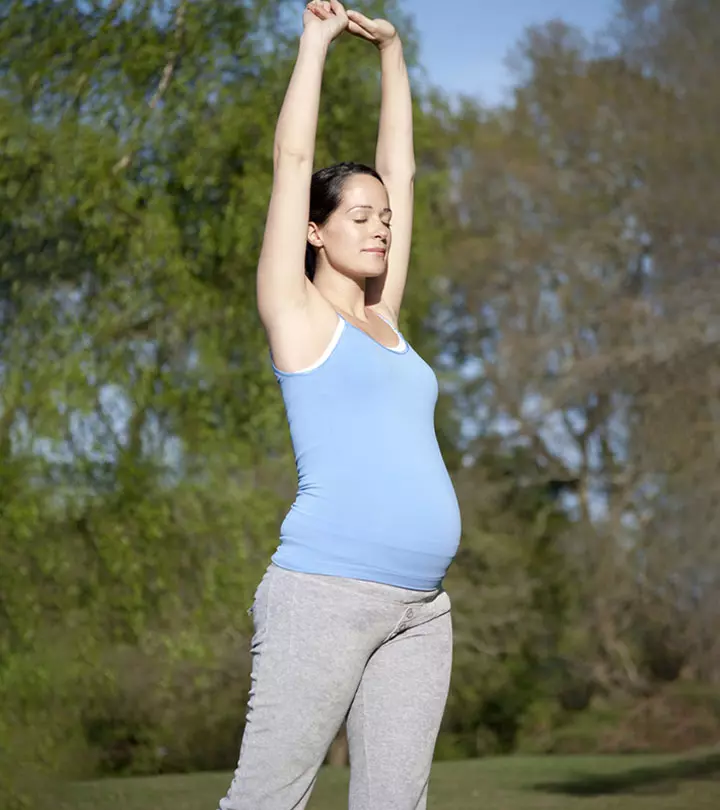
Image: Shutterstock
Regular exercise can help maintain and improve the physical and mental health of pregnant and non-pregnant people. For many, exercising during pregnancy is safe, provided they do not have a high-risk pregnancy. However, choosing the right exercises for pregnant women is essential to reap their benefits. Your OB/GYN can guide you to a trainer or an online program to help you learn how to exercise safely.

Read about the safety of prenatal exercising, the most suitable workouts, and the precautions while exercising during pregnancy.
Key Pointers
- For women with an uncomplicated pregnancy, indulging in around 150 minutes of moderate-intensity aerobic exercises per week is recommended.
- Safe exercises during pregnancy can help you have a healthy pregnancy and childbirth.
- Avoid exercises that may lead to an abdominal injury or over-exertion.
Is It Safe To Exercise During Pregnancy?
Since each pregnancy is unique, your healthcare provider can only advise you whether it is safe to exercise or not during pregnancy. Certain pregnancy-associated conditions may require the expectant mother to avoid all forms of physical exertion. Hence, your OB/GYN’s consent should be considered the gold standard (1).
How Much Should You Exercise During Pregnancy?
According to the American Academy of Family Physicians, pregnant women should indulge in around 150 minutes of moderate-intensity aerobics or exercises per week. You can divide the 150 minutes of exercise into 30-minute sessions across the week. Additionally, you could split the daily sessions into 10-minute workouts at different times to prevent overexerting yourself (1).
You can decide the frequency and intensity of exercises according to your preference. Moderate intensity comprises enough activity to raise one’s heart rate and induce sweating. With moderate exercise, you should be able to talk normally but not sing while exercising (2).
If you are new to exercising, take it easy. However, if you are used to working out vigorously before pregnancy, you can continue to do the same after childbirth. Ensure your calorie intake matches your total daily energy expenditure to prevent weight loss and other pregnancy complications (2).
A study determined the frequency and intensity of physical activity in women. Pregnant women with normal weight (NW) and pregnant women who were obese (OB) were interviewed during each trimester (T1, T2, and T3). They were asked to rank their level of physical activity during their leisure time and work from 1-4 (level 1 = sedentary, 2 = some physical activity, 3 = regular physical activity and exercise, 4 = regular hard physical training). As the graph below depicts, self-reported activity levels during leisure time were higher in NW compared with OB in all trimesters. However, they decreased significantly from T1 to T3 in both NW and OB over time.

Physical activity levels during pregnancy trimesters in both normal and obese women
Source: Physical activity during pregnancy and association with changes in fat mass and adipokines in women of normal-weight or with obesity; Nature Scientific ReportsWhat Are The Benefits Of Exercising When Pregnant?
The following are some benefits of exercising during pregnancy (1) (3):
- Healthy weight gain
- Reduced bloating and swelling
- Reduced back pain
- Constipation management
- Improved health and fitness
- Improved strength for childbirth and labor
- Postpartum weight loss
- Prevention of gestational diabetes
- Improved posture
- Improved mood and emotional well-being
- Improved sleep quality
How Might Pregnancy Changes Affect Exercise?
A woman’s body undergoes multiple changes during pregnancy. Hence, it is important to choose exercises that consider these changes (2).
- Joints: Pregnancy hormones can cause laxity in the ligaments to aid in childbirth. Since these ligaments hold bones in place, the risk of injury increases when these ligaments make the joints hypermobile. Hence, avoid any high-impact motions that increase your risk of getting hurt.
- Balance: Your increasing waistline and protruding belly can affect your mobility and shift your center of gravity. They can also add additional stress to the joints and muscles of the pelvis and lower back. Hence, you are more likely to lose your balance and fall since you are less stable.
- Breathing: While you exercise, your oxygen and blood flow are redirected to your muscles and away from the other body parts. Since your oxygen requirements increase when you are pregnant, your capacity to exercise may be affected, especially if you are overweight or obese.
What Are The Most Suitable Pregnancy Workouts And Exercises?
According to the American College of Obstetricians and Gynecologists, the following exercises are safe for pregnant women (2):
1. Walking
is an ideal exercise form for a full-body workout that is not too harsh on the muscles and joints.
 Experts say
Experts say2. Swimming and other water exercises
Exercising in water may help strengthen many muscles in the body. Moreover, water exercises are safe during pregnancy since the water supports your weight and helps reduce the risk of muscle strain or injury.
3. Stationary bicycling
Your growing belly can affect your body balance and make you more prone to falls and injuries, making regular cycling risky. Therefore, a stationary bicycle is a preferred option.
4. Modified yoga and modified pilates
Yoga is a low-impact exercise that offers several health benefits, such as reduced stress, increased flexibility, and improved stretching and rhythmic breathing. You can try trained yoga and pilates classes specifically designed for pregnant women. These modified yoga poses can safely accommodate a pregnant woman’s shifting balance. However, avoid poses that require you to be still or lie flat on your back for a prolonged time.
Carolina, a mother and a fitness enthusiast shares that during pregnancy she got into yoga and how it benefitted her. She writes, “But with pregnancy severely limiting my exercise options and my muscles starting to feel tighter and taking more strain in new places I decided to try and find my pregnancy zen and give it one more go. I was about 30 weeks pregnant at my first class, getting bigger and a little more unwieldy: relaxation and gentle movement were just what I needed.
“For the first time yoga and I got each other. Finally, I wasn’t struggling to keep up with a speedy sun salutation or wondering why a position felt so awkward while everyone else was doing just fine, instead, I realized that ultimately yoga is about calming the mind and reducing stress (i).”
The following stretches can help you be more comfortable and flexible during pregnancy (4).
5. Shoulder rotation
Ease and drop your shoulders forward, rotate them up towards your ears, and gently push them back down. Repeat four times.

6. Neck rotation
Relax your shoulders and neck and drop your head forward. Gradually rotate your head to your left shoulder, bring it to the middle, and then to the right shoulder. Complete four such rotations in each direction.
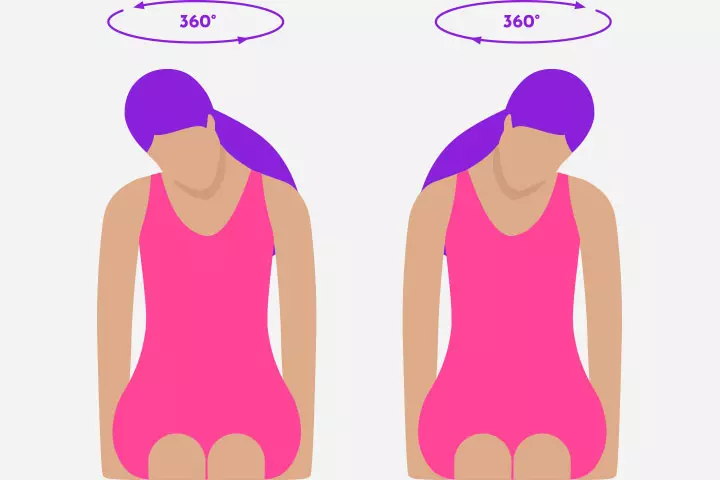
7. Thigh shift
Place your right foot around two feet in front of the left one. Point the toes of both feet in the same direction. Then, bend forward while supporting your body weight on the right thigh. Repeat the same on the left side, and do four on each side.

8. Leg shake
Sit comfortably and extend your legs and feet. Gently shake your legs upward and downward.

9. Swim
Place your arms by your side, and then raise your right arm. Extend your body forward and twist to the side as if swimming the crawl stroke. Repeat the same with your left arm. Follow this sequence ten times.
 Quick tip
Quick tip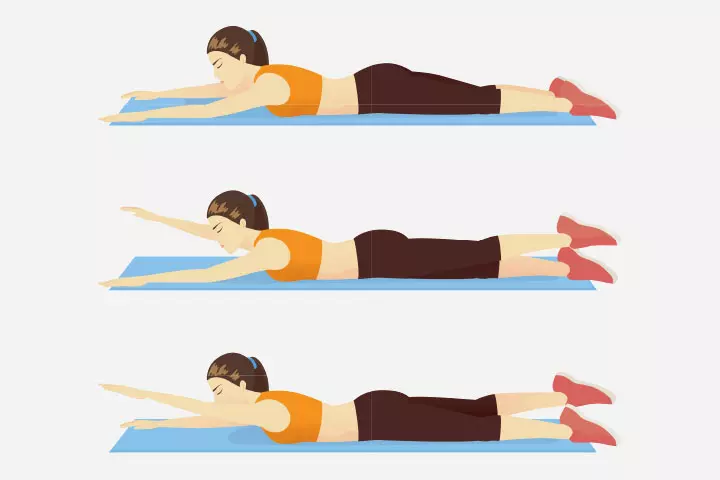
10. Ankle rotation
Extend your legs and relax your toes. Make large circles by rotating your feet in a clockwise and anticlockwise direction. Use your entire foot and ankle, and repeat four times.

These muscle toning and conditioning exercises can help prepare your body for childbirth by strengthening the muscles of your abdomen, pelvic floor, thighs, and vagina.
11. Pelvic tilt
Keep your back straight and get on your hands and knees. Use a mat under your knees to cushion them. Pull your abdominal muscles in and tuck your buttocks. Tilt your pelvis, raise your back to the ceiling, and count to five. Relax and repeat (5).
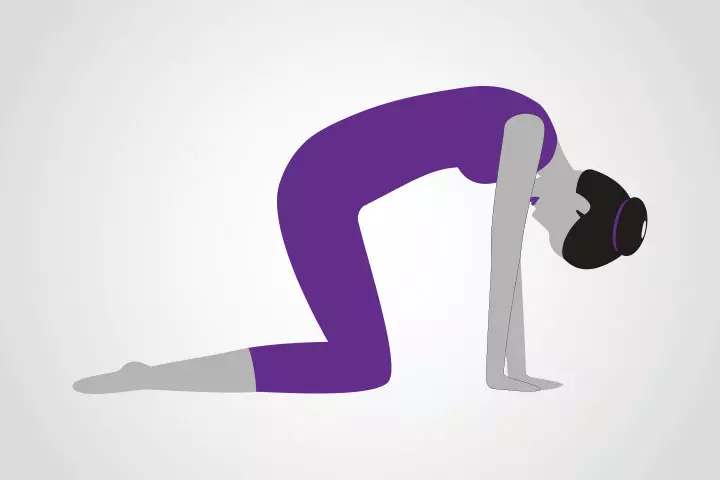
12. Leg lifts
Get down on your hands and knees. Put your arms under your shoulders and keep your knees shoulder-width apart. Round your back, lift your left knee, and gradually bring it to the elbow. Keep your knee slightly bent and extend your leg. Then, lift your leg till you feel a stretch in your lower back. Hold and count five and repeat with the other leg (5). This exercise is also good for enhancing core strength.
13. All fours
Get down on your hands and knees. Keep your hands and knees in line with your shoulders and hips, respectively. Your back should be flat, and your shoulders should be relaxed. Inhale and tighten your abdomen, tuck your buttocks in, and propel your pelvis forward in a single thrust. Relax, exhale, and ensure you keep your back straight. Repeat ten times.

14. Standing

Relax your legs, bend your knees slightly, and stand with your feet ten inches apart. Place your hands on your hips and inhale. Then, tighten your abdominal muscles, tuck your buttocks in, and push your pelvis forward in a single thrust. Exhale, relax, and repeat ten times.
15. Tailor sit
Sit with your knees bent and ankles crossed. Bend forward slightly while keeping your back straight but relaxed. Do this exercise multiple times a day.

16. Tailor press
Keep the soles of your feet together and sit with your knees bent. Hold your ankles and pull your feet towards your body. Place your hands under your knees and inhale. Press your knees down against your hands while pressing your hands up against your knees. Hold for five seconds and repeat.

17. Kegel exercises
Kegels strengthen the muscles of the uterus, bowel, and bladder muscles and aid in preparing your body for labor and delivery. They are also helpful in postpartum wellness to promote the healing of the perianal tissues, increase the strength of the pelvic floor, and improve bladder control (4).
 Quick tip
Quick tip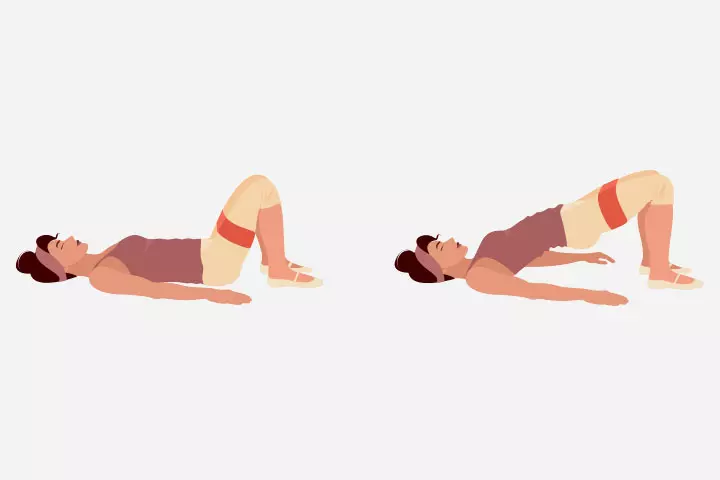
What Are The Safety Tips For Exercises When Pregnant?
These steps will help you exercise safely during pregnancy (2) (4).
- Consume ample water or electrolytes before, during, and after exercising.
- Focus on hydration if you notice any dehydration symptoms such as dizziness, racing heart, dark yellow urine, or small amounts of pee.
- Consume enough calories to avoid weakness while exercising.
- Wear a supportive and comfortable sports bra.
- Wear comfortable and supportive sports shoes.
- Exercise on a flat, safe surface.
- Stretch your body sufficiently before and after your workout to avoid injuries.
- Once your belly begins to protrude, wear a supportive belly belt to reduce discomfort.
- Wear loose-fitting clothing and exercise in a temperature-controlled environment.
- Listen to your body and stop when you feel tired.
- Consider consulting a prenatal physical therapist to create a safe workout plan.
What Are The Warning Signs That You Should Stop Exercising?
If you notice any of the following signs, stop exercising and contact your healthcare provider (2):
- Headache
- Fluid discharge from the vagina
- Vaginal bleeding
- Dizziness or fainting
- Shortness of breath before you start exercising
- Muscle weakness
- Calf pain or swelling
- Frequent and regular uterine contractions
- Chest pain
Frequently Asked Questions
1. Does pregnancy change how my body responds to exercise?
Pregnancy causes many changes in the way your body responds to exercise. For example, you may lose your balance often. Your expanding belly may put more pressure on your diaphragm, resulting in frequent shortness of breath. You may get tired faster since you may have reduced energy levels. Also, your heart may have to work harder and beat faster to provide the fetus with sufficient oxygen (6).
2. Is it safe to exercise in early pregnancy?
If you have an uncomplicated pregnancy, it may be safe to exercise during early pregnancy. However, your doctor will review your overall health and pregnancy to suggest when you can start exercising and what level of intensity would be safe.
3. Which exercises should be avoided during pregnancy?
The following are the exercises to avoid during pregnancy (3) (6):
- Activities that increase your risk of falling, such as horseback riding, skiing, skating, and gymnastics
- Exercises or contact sports that may cause abdominal injuries, such as boxing, ice hockey or basketball, or soccer
- Activities requiring excessive jumping, skipping, hopping, or bouncing
- Exercises requiring you to lie down flat on your backs, especially after the first trimester
- Exercises requiring you to hit the water with great force, such as diving, water skiing, or surfing
- Excessive bouncing while stretching
- Twisting the waist while standing
- Skydiving or scuba diving
- Exercises at high altitudes (more than 6000 feet)
- Exercises that may increase your body temperature, such as yoga
- Sudden intense exercises followed by long periods of inactivity
- Exercises in hot and humid climatic conditions
4. When can I start exercising after childbirth?
Most women with vaginal deliveries may be able to resume exercising a few days after childbirth. However, you may need to wait longer if you have a c-section (6). Your doctor will advise when it will be safe to resume workouts based on your overall health and childbirth.
5. Can I do squats while pregnant?
Yes. It is safe to perform body weight exercises like squats during pregnancy. Squatting may help open the pelvic region and make the labor process easier. It can also help improve blood circulation to the uterus and strengthen your hips, lower back, and legs (3). While you can do squats on a regular basis, you must not squat too often as over-squatting may strain the pelvic floor muscles and cause discomfort and pain, which could negatively impact your endurance during pregnancy (7).
6. Can I lift weights while pregnant?
Avoid large barbells and other heavyweights during pregnancy. However, with a doctor’s consultation, you may choose to engage in weight training with lighter weights. After the 12th week, it is advisable to refrain from lifting weights while lying on your back (8).
7. Is physical activity safe for all pregnant women?
Physical activity is generally considered safe for pregnant women, but it depends on their health conditions. Women without health issues that could be worsened by exercise are typically low risk, regardless of their previous activity levels. On the other hand, those with certain chronic conditions, such as heart or respiratory problems, are considered high risk. Additionally, women diagnosed with conditions such as gestational hypertension, preeclampsia, ruptured membranes, incompetent cervix, bleeding in the second or third trimester, multiple gestational risks for premature labor, placenta previa, and premature labor should refrain from physical exercises (9). Before exercising during pregnancy, it is vital to consider your fitness level and health status and consult your healthcare provider for personalized guidance.
Though exercising offers multiple benefits to pregnant women, always listen to your healthcare provider regarding the safe level of physical activity based on your health. As a thumb rule, avoid exercising till you are exhausted or uncomfortable. Take it easy, spread out your workout, and follow your doctor’s guidelines for relaxation. Further, ensure ample hydration and sufficient caloric intake to compensate for the lost fluids and calories while working out. Do not hesitate to talk to your doctor if you notice any unusual symptoms or discomfort when exercising at any stage during pregnancy.
Infographic: Exercises That Are Safe For Pregnant Women
Since regular exercise is an important part of a healthy lifestyle, it is recommended during pregnancy as well. However, not all exercises are suitable for a pregnant woman. Check out the infographic below to learn about certain pregnancy-safe exercises, but remember to talk to your doctor first and take all necessary precautions.
Some thing wrong with infographic shortcode. please verify shortcode syntax
Illustration: Safe Pregnancy Exercises And Workouts For Women

Image: Stable Diffusion/MomJunction Design Team
Exercising during pregnancy can be beneficial for both the mom and the baby. Learn how to safely stay active during this special time and how long you should work out.
Personal Experience: Source
MomJunction articles include first-hand experiences to provide you with better insights through real-life narratives. Here are the sources of personal accounts referenced in this article.
i. Pre-natal yoga: finding the pregnancy zen.https://bumpbumpandaway.com/2015/01/15/pre-natal-yoga-finding-the-pregnancy-zen/
References
- Exercise During Pregnancy.
https://familydoctor.org/exercise-during-pregnancy-what-you-can-do-for-a-healthy-pregnancy/ - Exercise During Pregnancy Frequently Asked Questions.
https://www.acog.org/womens-health/faqs/exercise-during-pregnancy - Exercise During Pregnancy.
https://americanpregnancy.org/healthy-pregnancy/is-it-safe/exercise-during-pregnancy/ - Exercise During Pregnancy.
https://health.clevelandclinic.org/pregnancy-safe-workouts - Pelvic Tilt Leg Lift for Back Pain During Pregnancy.
https://www.saintlukeskc.org/health-library/pelvic-tilt-leg-lift-back-pain-during-pregnancy - Exercise During Pregnancy.
https://www.marchofdimes.org/find-support/topics/pregnancy/exercise-during-pregnancy - About Physical Job Demands and Reproductive Health;
https://www.cdc.gov/niosh/reproductive-health/prevention/physical-demands.html?CDC_AAref_Val=https://www.cdc.gov/niosh/topics/repro/physicaldemands.html - Strength training in pregnancy
https://www.tommys.org/pregnancy-information/im-pregnant/exercise-in-pregnancy/strength-training-pregnancy - Sally K. Hinman et al.; (2015); Exercise in Pregnancy.
https://www.ncbi.nlm.nih.gov/pmc/articles/PMC4622376/ - Healthy Pregnant or Postpartum Women.
https://www.cdc.gov/physical-activity-basics/guidelines/healthy-pregnant-or-postpartum-women.html?CDC_AAref_Val=https://www.cdc.gov/physical-activity-basics/guidelines/healthy-pregnant-or-postpartum-women.html?CDC_AAref_Val=https://www.cdc.gov/physicalactivity/basics/pregnancy/index.htm - Swimming in pregnancy.
https://www.tommys.org/pregnancy-information/im-pregnant/exercise-in-pregnancy/swimming-pregnancy - Kegel exercises – self-care.
https://medlineplus.gov/ency/patientinstructions/000141.htm
Community Experiences
Join the conversation and become a part of our nurturing community! Share your stories, experiences, and insights to connect with fellow parents.
Read full bio of Dr. Mona Hardas
Read full bio of Dr. Ritika Shah
Read full bio of Rebecca Malachi
Read full bio of Dr. Joyani Das

















